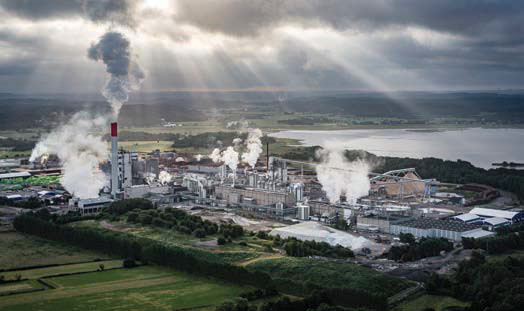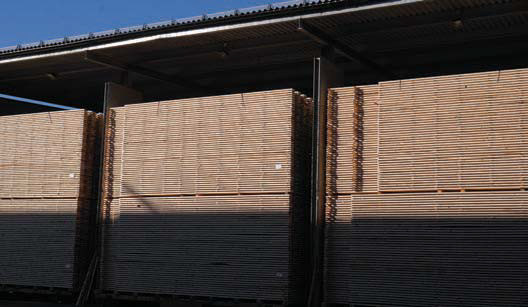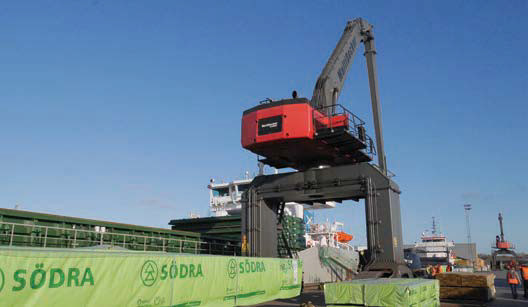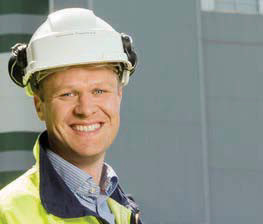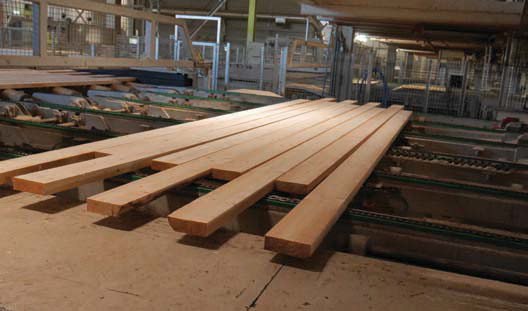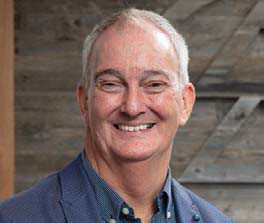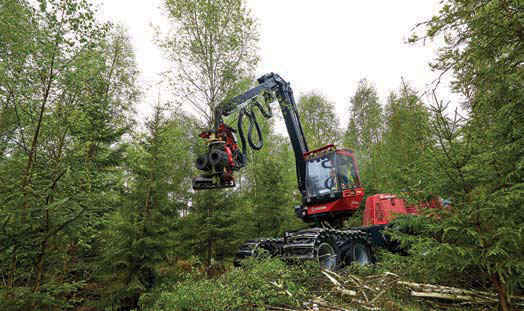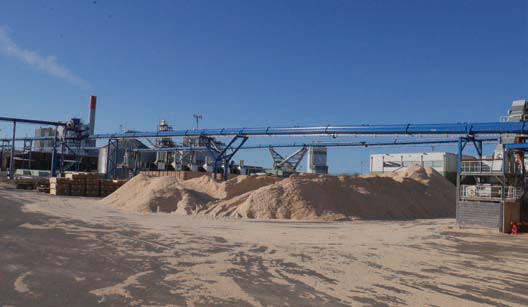Sowing seedlings for the future
16 January 2019Södra’s traditional co-operative business model continues to deliver growth and innovation – including in the UK. Mike Jeffree reports
Södra, one of the UK’s single biggest timber suppliers, and committed to growing its business here, Brexit or otherwise, is not just about the big numbers. That said, those numbers are impressive and even more so seeing the actual scale of the operation they represent on a whistle-stop tour of the company’s colossal Värö mill site and supporting forestry operations.
Södra was 80 last year, which means trees planted when it launched are now being harvested. And, famously, it is a co-operative, with part of the business belonging to a total of 51,448 southern Swedish forest owners. Between them they manage 6 million acres of woodland, supplying some 4 million m3 of logs for the company’s seven sawmills, which are also serviced by two treatment plants, and 10 million m3 for its three paper and dissolving pulp plants.
“A core function of the business since the outset has been sustainably to maximise yield from their forest for the individual owners,” said key account manager, Södra Marcus Larsson. “They not only sell their timber to the production facilities, they share in the company’s profits – and it’s a model that still works. New owners continue to join Södra, with the total increasing by over 1,000 in recent years.”
Combined output of the mills is 2 million m3 a year, with some 1.4 million m3 further processed, and about a third of production destined for the UK. Pulp capacity is nearing 2 million tonnes per year.
These latest totals follow a major recent investment programme totalling around SKr6bn. The lion’s share of this went on expansion of the Värö Södra Cell pulp plant, increasing capacity from 400,000 tonnes to 700,000 tonnes. But there has also been significant spending on development and expansion of timber operations. Key, in terms of the evolution of the business, is construction of a cross-laminated timber (CLT) plant at Värö. In conjunction, sawn timber capacity at the Mönsterås mill has been boosted by 100,000m3 a year to offset the volumes of material that will now be consumed by the CLT facility (about which, more later).
Södra clearly also sees the acquisition of its UK distributor Crown Timber and the latter’s 2017 rebrand as Södra Wood Ltd as very much part of its timber business development.
“The move clearly underlines Södra’s ambition in the leading market for its developing timber operations and products,” said Nigel Buckley-Ryan, UK sales director, merchants, Södra Wood Ltd. “As the business evolves, it feels it’s vital to raise its corporate profile and build market awareness of its integrated supply chain back to the forest. To that end, Södra is very much now the name over the door in the UK.”
Integrated supply chain
The Värö sawmill epitomises the integrated nature of Södra’s operations. It sits on a 300-acre site alongside the massive pulp facility, with conveyors linking the two, carrying wood residues and bark to the pulp plant as raw material and fuel for its heat and power plants. The latter not only enable the facilities, including the sawmills’ kilns, to operate fossil fuel-free (a target for all Södra production sites by 2020), they also feed the surplus from the 1600Gwh of electricity generated annually into the public grid.
The sawmill was built seven years ago and at the time received more media coverage than the average timber sector construction project. That was due to the fact that it had originally been Klausner’s plant in Adelebsen, Germany. The German company decided the nearly new facility was surplus to requirements, so it was sold, disassembled and freighted the 850km north to Värö where it was reconstructed by a joint Södra and Klausner team.
“It was a major logistical exercise,” said Markus Åsgärde, Värö sawmill manager. “As the mill was only a year old, not all systems had been optimised either. It took us three to four years to fully realise its potential, until today production is around 600,000m3 and planed output 430,000m3, making it Södra’s biggest mill.”
The plant consumes around 1.2 million m3 of logs per year, 15% pine and 85% spruce, and with the automated log scanning line running at 165m/min, and planing lines a blur at 860-1,100m/min, it keeps around 250,000m3 in stock.
Most raw material is from Södra forests, but this is complemented with logs from Norway, Denmark, Poland and the UK.
“For maximum efficiency, we’ve streamlined production to principally strength-graded C24, CLS, dried and undried sideboards,” said Mr Åsgärde. “The remaining bottleneck is kilning, but we’re looking to increase capacity here too.”
Finished product from Värö is mainly shipped from the nearby port of Varberg, the bulk heading for the UK, followed by the US, Asia and elsewhere in Scandinavia.
Seedbeds and test beds
Also close by at Falkenburg is where the whole process begins, one of Södra’s two giant tree nurseries. Between them they cultivate 26 million saplings a year, with a further 10 million externally sourced.
“That amounts to around 35,000ha of forest planted annually,” said Tord Baron, Falkenburg nursery site manager, and a forest owner himself. This, however, is not the full story, he added. The nurseries are also effectively R&D facilities.
“Through long-term cultivation, and categorically not genetic modification due to our commitment to FSC and PEFC certification, our trees grow faster and produce more timber than 20 years ago,” said Mr Baron. “Cones are 25% bigger, so produce more seeds, and a tree planted today will be ready for harvest at 50-60 years, as opposed to the 70-80 years of the past.”
The nurseries are also taking into account the impacts of global warming, hotter, dryer summers, and more severe storms.
“It’s a case of planting the right tree in the right place,” said Mr Baron. “We also mix hardwood and softwood, with 120 million deciduous trees planted in recent years. This not only improves biodiversity, it adds to the resilience of the forest.”
Changing weather patterns are also predicted to increase prevalence of insect attack. But that’s where another product from Södra’s Värö Innovation Centre comes in.
The company is very open about most of its operations, welcoming customers – and trade press – to scrutinise every aspect. Production and application of its Cambiguard plant protection membrane, however, is different. It’s a key development delivering significant competitive advantage and it’s strictly no photographs.
“It was developed as part of our strategy for forest operations to go chemical-free,” said Mr Baron. “It’s a stretchable material which is effectively painted on every sapling and ‘grows’ with it for about two years, after which time the tree is less vulnerable to insect pests.”
“Even Cambiguard’s pale colour plays a role,” said Jeremy English, GB and Ireland sales director, manufacturing. “It means any insects that land on it are more visible to birds that prey on them!”
Out in the forest, while Södra’s felling operations employ the latest 20-tonne harvesters, capable of cutting 70+ trees daily, planting is still done by hand tool. It’s still seen as the best way, and at the same time is also pretty efficient, with experienced personnel capable of planting 1,500 saplings every day.
Planting and felling plans are managed jointly by the forestry team and owners, with drones now significantly speeding up the process, as well as being used to spot areas of windblow, fungal or insect attack or disease.
As the increase in owners joining Södra recently highlights, it’s an arrangement that suits both parties. The wider business secures its raw material supply, while the owners have the trouble of managing their property taken off their hands, plus a source of income, combining the sale of timber and their share of company profits, which has consistently outpaced stock market growth.
Foundations for growth
Looking forward, CLT clearly forms an important part of Södra’s plans. The new factory sits next to the Värö mill and the machinery is now going in.
“Initial production, with start up in the second quarter of 2019, will be 20,000m3 a year, but we envisage that rising to 100,000 relatively quickly,” said Mr English. “CLT is in growing demand in construction and being used for increasingly ambitious projects internationally, including, of course, in the UK where we see major opportunities for production out of Värö.
“Part of my role is to develop the market for engineered wood and this year I was a judge for the UK Structural Timber Awards, which highlighted the incredible buildings using wood as their key component already being delivered. Together with the increase in offsite construction, we see significant potential here and, of course, a market that will generate even further value to our owners’ forests.”
At the same time, he stressed, Södra has no plans to follow the example of some other Nordic producers and move into timber-based construction itself.
“We’re not going into competition with customers,” said Mr English. “We’re remaining neutral in the market, working with customers to provide solutions for challenges they present us with, such as ensuring BIM compliance of our product range, for instance.”
As far as the wider UK and Ireland markets are concerned, Södra, now with its ‘name over the door’ of its business, also sees potential for growth and development of its other product lines; planed structural timber and treated material for the roof truss, timber frame, industrial and timber and builders merchants sectors. And underlining the breadth of its ambition, and commitment, it is now a member of the UK Structural Timber Association, Builders Merchant and Timber Trade Federations.
Further developing and strengthening ties with the merchant community is a particular focus of Mr Buckley-Ryan.
“We’re still relatively immature in the merchant business and there’s great opportunity to grow,” he said. “We’re building relationships across the spectrum; from multi-chain operations and large buying groups, to smaller independents. And it’s particularly exciting in this respect that we’re now an even more fully integrated element of the wider Södra operation, with both a market and production focus, which we believe benefits not just us, but customers too. We want to build real brand recognition in the sector, with our Nirvana being merchants, and indeed other customers, increasingly specifying Södra Timber by name.”
And, added Mr English, Brexit will not diminish Södra’s engagement with the UK market or ambition to grow its business here.
“Long term there’s no change in our commitment to the UK and short term we’re working with customers to ensure the minimum of disruption to business,” he said. “And we can confirm we’re increasing Great Britain and Ireland landed stock 10-15% to tide us over any temporary hold ups at ports and customs.”
Longer term still, Södra also sees the UK among target markets for the very latest concepts from its Innovation Centre. These include new cellulose fibre-based textiles – some of which featured at London Fashion Week – and even wood-derived jet biofuels, on which it’s currently working with KLM.
It sounds like after 80 years the company is still breaking the mould, although it stresses that latest developments also tie in with long-standing core goals; to maximise sustainable yield from the forest, maximise return to its forest owners and ultimately make those big numbers bigger still.
